Adriana Oprea: The world (and I mean the ”art world”) could say: painting again, another painter from Cluj who left for Berlin, who wants to “make it big abroad”? What sets Sebastian Hosu apart from all the recent plethora of male and female painters who learn painting in Romania, go abroad and try to build an international artistic career in contemporary art?
Lotte Laub: I get the impression that Sebastian Hosu would eschew such an attribution. You can already see in his paintings and drawings how everything seems to be in motion. He, too, has moved around a lot: he grew up in Satu Mare and studied in Cluj-Napoca, then in Turin and Liège, and finally in Leipzig where he currently lives. By his own account, he was more interested in different impulses and approaches than in seeking out particular professors, and this is what enabled him to develop an idiosyncratic artistic practice early on. Sebastian Hosu is also younger than artists such as Adrian Ghenie or Marius Bercea, and much younger than Neo Rauch, and he never experienced the “turnaround” in Romania, the radical transition from one system to another, and the subsequent post-communist era with all its contradictions. I can only give you my impression, of course, but I think that’s why Hosu focuses on different questions. In his case it’s less about failed utopias, as for him communism was already history. His artistic practice is possibly informed less by an existential “in between”, between an unprocessed past and uncertain future, and more by the search for new possibilities of expression in the painted image, and for counterbalance in a world that is increasingly influenced by artificial intelligence. The text for his latest joint exhibition with Antonio Pauciulo says that both artists see painting as a haptic language that is capable of fostering an ecological view. I also get the impression that there’s a renewed appreciation for painting in theoretical discourse, which is something I personally find interesting. Painting is also the focus of Sebastian Hosu’s artistic work, but drawing, too, and he succeeds in combining them in an impressive way. The image we used to announce the Leisure Life exhibition – On green floor III (2019) – is one of these charcoal-oil hybrids.
Likewise, the art-world might again comment: painting again? Were we not over with it, will its story ever end in contemporary art? As I was joking with Cristina Stoenescu at the gallery while visiting your exhibition with Sebastian Hosu: if there will ever be an atomic catastrophe, painting is still meant to survive. If mankind moves to the Andromeda galaxy in an effort to survive any cataclysm, painting will be there as well, flourishing undisturbed in the Andromeda galaxy. As you well know, there have been successive waves of painting comebacks in contemporary art, both on an international scale, and on a smaller, local scale – in Romania over the last decades. We can name the last calendar sequence of art events locally, as Cristina has already done, a “winter of painting in Bucharest” (to the exasperation of many of those active in other areas of the art scene in Bucharest and Romania: “Painting again? We got tired of it!”). How does Lotte Laub, the art writer and curator, working in a contemporary art gallery, see the survival, persistence and continued success of painting in all its forms in art produced today?
I like the reference to the Andromeda galaxy. The sound installation Estranged Music that the artist Selçuk Artut showed at the Dystopia Sound Art Festival 2018 in Berlin suddenly springs to mind. The starting point for this work was the idea of an atomic catastrophe in which all musical recordings were destroyed besides those that travelled with the spaceship Voyager on its 1977 trip into space and which became the only source available for the reconstruction of music. This work leads me in turn to the artist and thinker Jalal Toufic who states in his essay “The Withdrawal of Tradition Past a Surpassing Disaster” that an immeasurable disaster – which for him means destruction resulting from war, genocide, colonial occupation and other violent interventions – not only involves material destruction but, according to Toufic, immaterial devastation, too. Even if books, paintings, libraries, museums and so forth have survived or been refabricated, restored or rebuilt, tradition has immaterially retreated. The impact of this immaterial withdrawal of tradition goes beyond the catastrophe itself and it is experienced as an absence – and Toufic considers it a difficult endeavor for an artist and thinker to reconnect with one’s own tradition. Returning to the music recordings on the Voyager: they’re unable to preserve musical tradition and can basically only show what’s been lost. They do provide impetus for reinvention, however. If we designate painting an “undead medium” then the painter’s task is to meet this challenge of reconnecting with tradition in the aftermath of the respective immeasurable disaster, for example the misuse of painting for state ideologies. More recent media are less disadvantaged here. So it is less about why painting experiences a renaissance time and again and more about how artists address this challenge.
Of all the young artists who paint today (in Romania there are many who are extremely talented, some discovered and promoted locally and internationally, others – still unknown; not to mention also how many international artists paint in a place like Berlin), how did you choose to work with Sebastian Hosu?
The idea to present a solo exhibition by Sebastian Hosu in Bucharest came from Anca Poterașu, whose gallery was the guest gallery for a year at the Spinnerei in Leipzig. Anca Poterașu invited me to curate an exhibition with Sebastian Hosu, supported by the Goethe-Institut, when we were both at Artissima in Turin – she was presenting a solo booth by artist Larisa Crunțeanu while I was with Zilberman Gallery and artist Simon Wachsmuth. Anca already knew that I had a link with Bucharest in my private life, the same with Sebastian Hosu and Berlin. Even though I’d never met Sebastian Hosu before, his charcoal drawings and paintings appealed to me immediately.
My research work has looked at the works of the film auteur, video artist and poet Ghassan Salhab. Film is a time-based medium and it was particularly the movement of the figures in Hosu’s drawings and paintings as well as the body-space dynamic that appealed to me. It was only later, after some discussions with him, that I learned about his work with vernacular photography, the starting point for his inspiration. I find his research interesting not only for its discursive nature, specific references and political nuances, but also for the abstraction process, from the black-and-white photographs up to the charcoal drawings and oil paintings. What is the abstraction subject? How does Sebastian Hosu work with black-and-white photography? How does he use color? Taking a closer look, it becomes clear how moods change with his choice of color, how stillness becomes movement and vice versa, and how the exertion of force is expressed by emphasizing verticals, horizontals or diagonals, or by changing the distribution of weight – a free-hanging leg here, a leg in support mode there. Hosu’s paintings are often produced in a large-scale format, which particularly caters to our embodied perception when standing in front of them in the exhibition.
In the case of Sebastian Hosu, the call to photography as inspiration for the production of these pictorial images with a lot of nature in them is ambiguously intertwined with the call to nature itself. That is, if his drawings and paintings start from photographs with people in nature, the paintings themselves that result from this seem like free studies after nature (free of any prior photography) – a paradox. The mediation of photography (or the photographically mediated image) seems to serve the concealment of mediation: the resulting pictorial images present themselves as fresh and vivid studies, sketches, spontaneous sketches after nature, exercises of pictorial virtuosity – études après nature, without any kind of photographic mediation in them. If in the “school” of Gerhard Richter the paintings are frozen, “dead” – because they are made using / referring to photography; in this case, the paintings, also being made through photography, are still alive and explosive, bursting with life. The painting uses photography to “escape” from it. Is this intuition / observation correct about Sebastian Hosu’s painting?
Sebastian Hosu has looked at vernacular photography from East Berlin from the 1960s and 1970s, black-and-white photos taken on family trips to the lakes around Berlin. The photos are actually from his partner’s family archive and thus create a personal and biographical reference. In Sebastian Hosu’s paintings and drawings, you don’t necessarily pick up on the fact that he’s been working with photographs. But on a second look I asked myself how he chooses his motifs. They’re often athletic bodies or groups of figures in motion in a particular landscape. Certain motifs, such as “tug of war”, a competitive team sport that is also old-fashioned, as if indicative of another time, recur over and again. Recurrence of, say, the tug-of-war motif in the drawings, charcoal-oil hybrids and paintings gives his works an impression of being studies, as if they were something he was working on. In his oil painting Outscape I (2016) only fragments are used, individual limbs standing out from the background.
In the exhibition, the photographs are shown as a slide projection, but they’re not center-stage, as they’re being shown in the smaller exhibition room where the focus is on Hosu’s charcoal drawings. The projection is almost at floor level at the bottom of a historic wall. It is shown in a small-scale format and visitors are free to operate the projector. The light from the projection underpins the photographic medium and also plays an important role in Sebastian Hosu’s works, while the sound of changing slides supports sensory perception and activates our own memories. The photography represents a starting point, in a way creating a spark that triggers the next process, like in the video The Way Things Go by Fischli und Weiss. Once the drawing and painting process starts, the photographs retreat into the background. The tension between the slides, with their concrete historical link, and Sebastian Hosu’s works, with their almost archetypal motifs, is an interesting one.
In an essay on cinematic theory, Mirjam Schaub states that the ear is also the “organ of fear”. Our hearing not only serves our sense of stability vis-à-vis our surroundings, as it can also destabilize us. “While the eye searches and makes rich pickings, the ear listens to what’s preying on us.” The drawings seem to include both counterparts: preying and being preyed on. They have been hung on the basis of the horizontal line that marks out a space in each work. By positioning the lines at the same height, an unbroken horizontal line is created, as if we were gazing at a horizon. It’s a question of representation. The row of pictures ends with the tug-of-war motif, as if the group of figures were pulling the horizontal line away, turning the observer’s seemingly stable orientation point (horizon) into an uncertain one. This way, the body-space relationship is expanded to include the viewing area.
I also think that the relationship between photography and painting in Gerhard Richter’s oeuvre is different to the one in Sebastian Hosu’s works. Bearing in mind Susan Sontag’s comparison between photography and the “death mask”, for example, and Richter’s “devotional pictures”, then I agree that in Sebastian Hosu’s paintings we’re talking more about vivification. Striking in Hosu’s works is the way that the material surface contrasts with the smooth, non-tactile trace of view in the photography. I perceive a content related and formal sense of inspiration emanating from the photographs, both for the artist and the recipients.
In connection with the appeal of contemporary painting to photography – only a more recent episode in the long history of the relationship between the two mediums, henceforth both traditional, painting and photography since the nineteenth century – it’s being said more or less on a serious note that if a photographer can make blurred photos, it is harder for a painter to make blurred paintings. There is blurred photography, but can there be blurred painting? Sebastian Hosu also uses, like other Romanian and foreign painters, painting tricks that “melt” the realistic representation, hide the image, destroy the figurative elements, decompose the layers of reality corrosively, leaving ruins, fragments, clues of reality on the canvas: e.g. it is immediately detectable the technique of drawing the paste on the canvas as if one “handled” the image with its “makeup”, a technique that is correlated with painters like, more recently, Adrian Ghenie. Why does Sebastian Hosu smear the rendering of photographic images with people having fun at an outdoor picnic in, otherwise benign, common or, in any case, harmless images? What role does such technicality play in Hosu’s paintings? Is there a relationship between technique and theme in his painting?
Wittgenstein once asked, ”Is it always an advantage to replace an indistinct picture by a sharp one? Isn’t the indistinct one often exactly what we need?“ and in doing so perhaps expressing precisely the impossibility of establishing the truth and the necessity to be aware of this impossibility. Sebastian Hosu’s works are less driven by a dystopian attitude, however; quite the opposite: it’s a hopeful one. He talks himself about his “lively relationship with the emerging picture”.
In the paintings and hybrids, the compositional elements seem to be involved in a dialectic. The antagonisms can be seen in On green floor III (2019), the image we used to announce the exhibition: force and counterforce, all the lines and color fields are striving to reach the right edge of the picture and are doing so along a line that, compared to the original photo, has been pushed upwards. The color fields and their distribution suggest a downward movement; the upper blue field widens to the right; the pink field twists to the ground; and the charcoal fields correlate in a downward slant. The charcoal fields imitate the black-and-white photography: on the left the dark field, on the right the black skirt. So, the charcoal is imbued with a reminiscence of an earlier experience from the era of black-and-white photography, while the green floor and all the other colors from the current era reflect the greater sense of aliveness.
There’s another great quote from the Italian philosopher Carlo Michelstaedter: “No life is ever satisfied to live in any present time, because it is life insofar as it continues into the future.” What follows is a paradox: “As soon as it continues into the future, it lacks of life.” Michelstaedter’s words contrast with the widely held assumption that life only fully unfolds if it’s playing out freely in the “here and now”. But life would cease being life if it were devoid of any expectations for the future, as the moment of satisfaction longed for by the living being would be their death. Results may indeed remain fragmentary, but Sebastian Hosu sees the creation of meaning as a deep-seated human need. It is therefore movement itself, or the path or the process, that constitutes the actual goal.
Indeed, the technique of Sebastian Hosu’s images is a powerful presence: perhaps not so much the oil of the paintings as the coal of the drawings. There are nervous images, even a little hysterical, vibrating, pulsing with energy: a force that is seen not only in the representation of people, but especially in the representation of nature in the background and around them. There is a vivid and rich black, not at all neutral or opaque, who advances to the foreground competing with human figures. Coal is a classic, “school” technique for any painter who respects himself: you try your hand, technicality, carbon virtuosity and if you are talented and master the technique, your images are very strong (all great painters have in their careers, aside from their paintings – masterpieces that make them known to the “big public”, some amazingly skilled pieces proving their artistic dexterity of this kind (the sketches behind the big paintings, etc.), pour les connoisseurs. Besides the effect of black / white, reminding us of photography, given by the coal of these images – images that also start from photography – there is however an absolute opposite, contradictory effect: non-photographic, non-mechanical. Coal as an “old”, manual, direct, gestural, “muscular” technique, one could say, a technique which facilitates the traditional means for the painter to manifest himself “bodily”, directly, in his craft. There is something primary, elementary, almost rudimentary – very non / pre-modern in Hosu’s charcoal drawings, which is why they look old, non-photographic, old school, old media, even pre-photographic. I think this is their force of impact on the viewer. What do you think of this possible ambiguity (modern photography, chic vs. “old”, “aged” technique) in the internal laboratory of Hosu’s images (if you think it exists, really)?
For the exhibition, Sebastian Hosu began by producing a larger-than-life drawing in situ. In our discussions, he talked about the blackness, the light-dark contrasts and the charcoal texture. This drawing is also Hosu’s biggest to date. In contrast to other drawers whose work is often small-scale and fine, it’s the physicality that’s noteworthy here, as the drawing requires use of the whole body. I don’t think the artist intends any ambiguity or even dichotomy between “modern photography vs. old technique”. I think it’s more about bringing out the archaic and the archetypal from the photographed situations.
Much like the presence of black and the “honest” colors – colors without inhibitions and without who knows what shades and refinements, frontal and sincere colors – the subject of Sebastian Hosu’s images is also dynamic: as you also observed, “leisure time” is not something static and quiet, soft and indolent – on the contrary, it is always impetuous, energetic, intense in Hosu’s work. If, as you say in the curatorial text, leisure time is that other than work, that is, other than productivity, so is the area of apparent freedom (authentic or false – a freedom allowed and discreetly controlled in the background by ideology), then Sebastian Hosu‘s “freedom” is very “nevrotic/nervous”, unleashed as a pulsating physiological force: freedom as a nervous apparatus in full action. It is something deeply troubled, an energy that “does not sit in place” in any of his images, which must be discharged in one way or another through the pictorial image – electrical painting. I think of the contrast with the “leisure time” of the peasants who rest in the field work, peasants at rest – a classic theme of modern painting (and Sebastian Hosu certainly studied in school the classic Romanian landmark: the canonical Romanian painter Corneliu Baba with Field rest), the ancestor of contemporary “leisure time” represented in recent painting. The peasant “leisure time” was static, passive, drowsy, resting in modern painting – nothing like the painting on Popa Soare street no. 26: everything is hectic here, in constant motion, urban, torn, dynamic. What is the connection / is there a connection between the representation (photographic and then re-mediated by painting) of the free time lived by people in a country of the former communist East of recent Europe and these disruptions of energy, this nervousness, these dynamic, restless images?
I find these considerations interesting, the thinking about leisure-time images in Romanian painting in the communist era and in these works, particularly as the works at hand relate to photographs from a similar period. It raises questions about social systems, agricultural or industrial society. Dynamism, restlessness and speed isn’t only expressed in panting today, of course, but is a reminder of other movements, too, for example Futurism. But in Futurism the dynamism is associated with an enthusiasm for technology. This is different to Hosu, as he reflects on the alienation from nature, expressed through the athletic body – with sport as something heavily formalized and artificial. For Hosu, movement is also about wanting to rip people out of their supposed predominance. Deadlocked relationships are dissolved, creating the space for something new.
Is there something in Sebastian Hosu’s work reflecting the thematic family of the “East-West” / “Former East-West” / communism vs. capitalism / freedom versus trauma / democracy vs. oppression / present vs. past / immersion in present living vs. nostalgia (photographic) for something irreversibly lost? That is, is there something in his painting from this highly frequented thematic family in all of recent art, both Eastern and Western, something translated theoretically and conceptually through books such as Future of nostalgia (Svetlana Boym) or Requiem for Communism (Charity Scribner)? I mean (without any parade of names), is his painting to be framed and felt / intuited through such lenses, through such filters of understanding and feeling (as the exhibition seems to guide us by the overt references to the anonymous photography from East Berlin in the 60s-70s)?
I think it’s interesting to see that Sebastian Hosu worked with vernacular photography from the GDR era, a very specific reference, so the East-West thematic complex is implicit. Particular motifs in the photos may remind us more readily of the GDR period, the orchestration of leisure-time activities and the collective, but also the breakout into nature as the final retreat.
Sebastian Hosu and Antonio Pauciulo write: “We see painting as haptic language that is capable of fostering an ecological view, challenging the prevailing technological belief.” For them, it is also about criticizing the attribution of roles that has become entrenched. At the same time, through movement and combination, Sebastian Hosu is opening up the possibility of new relationships, including the one between ourselves, as observers, and the pictures: it’s not just a matter of our observing the pictures, they’re also looking back at us. Presence effects addresses embodied perception and our attention is focused on both the pictorial space and the viewing space, so that we’re no longer merely the observing subject but also objects of self-observation.
The solo exhibition Leisure Life by Sebastian Hosu is curated by Lotte Laub. It takes place from 15 December 2019 until 31 January 2020 at Anca Poterasu gallery in Bucharest. With the kind support of the Goethe-Institut Bucharest.
POSTED BY
Adriana Oprea
Adriana Oprea is an art critic and historian. She has been publishing essays and reviews in Revista 22 and is a collaborator of Revista ARTA since its relaunch in 2010. In 2006 she started working in ...
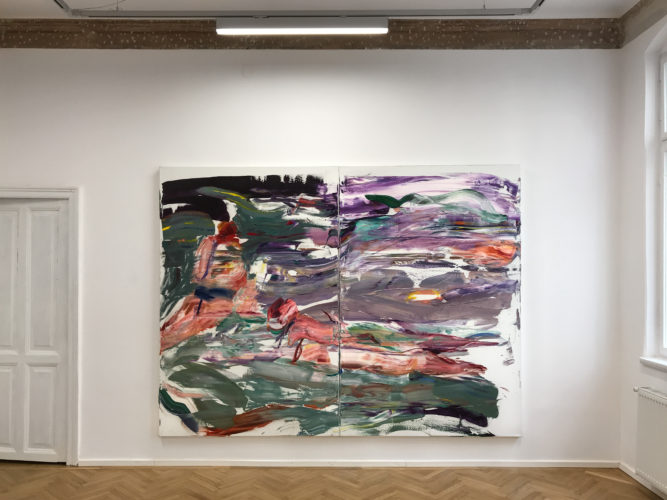
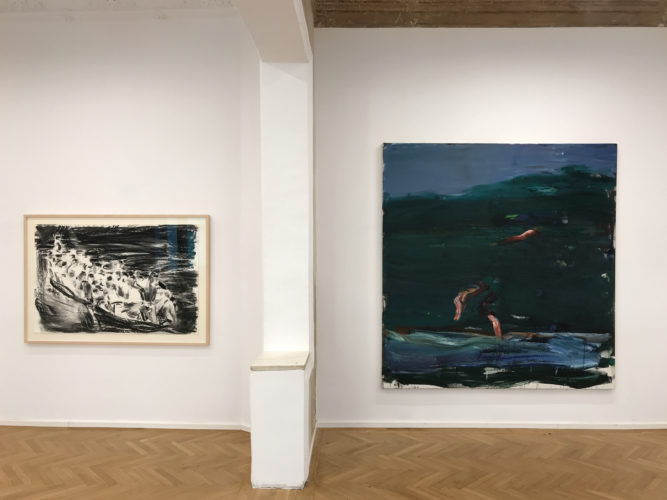
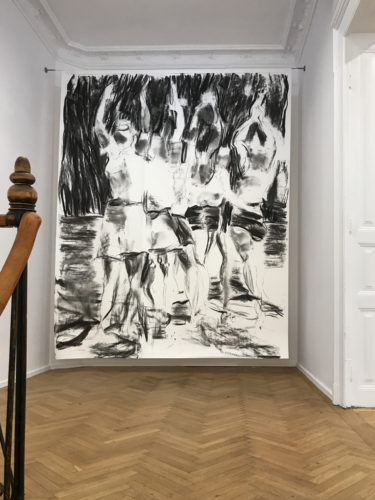
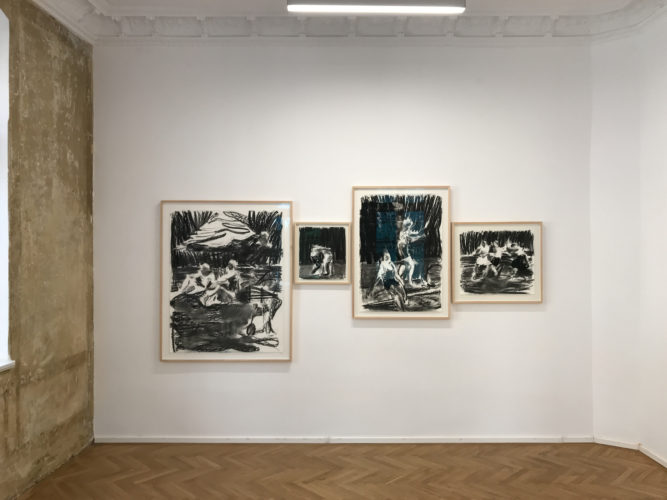
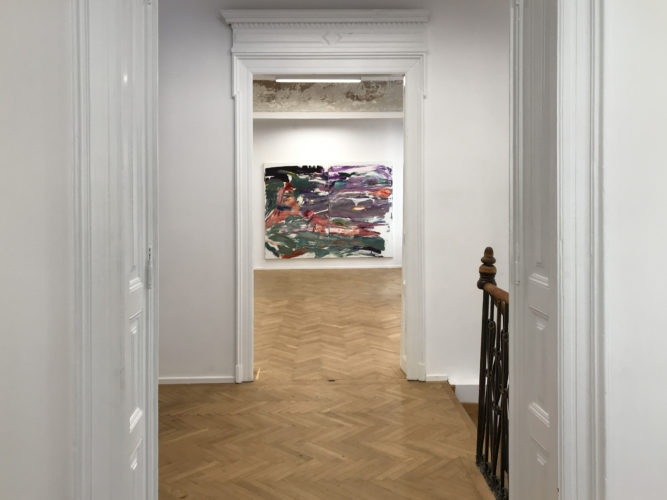
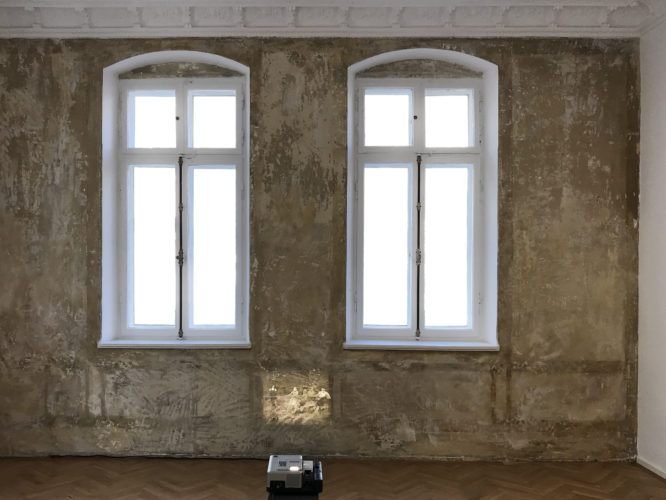
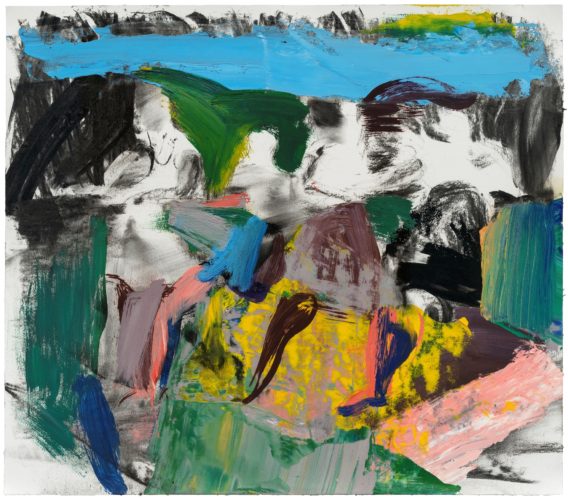
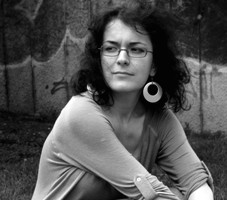
Comments are closed here.